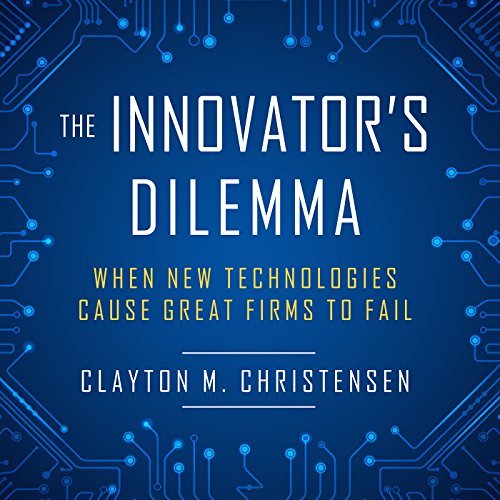The Innovator’s Dilemma: When New Technologies Cause Great Firms To Fail

Physical Copy:
Audiobook:
By: Clayton Christensen
Rating: B
The author, Clayton Christensen, was a Rhodes Scholar and a Business Professor at Harvard. This book is a reference book for many silicon valley leaders. It won several awards and has been named one of the most important business books ever written. Those are all bold claims. So the book grabbed my attention.
Summary:
Lesson 1: There are two types of technologies used in innovation: sustaining and disruptive. Understanding which technologies fall into which category is key to a company’s success.
Definitions:
- Sustaining technologies. These focus on growing existing technologies by enhancing their performance, mostly through extended functionality or increased capacity.
- Disrupting technologies. These change the landscape of an entire industry, or spark a new one altogether, because they solve a problem in an entirely new way or for an entirely new group of people.
Sustaining technologies are often already accepted by society. They are a large market. Think of all of the reiterations of the iPhone. We have accepted these small changes and we generally expect our smartphones to make calls, text, and take pictures. There is inherently less risk in these innovations, therefore, there is significantly more competition. It is very difficult to enter the market and be successful due to the price point and competition of sustaining technologies.
Typical Sustaining Company Practices
- Listening to customers’ opinions
- Improving the features of technologies that are already working
- Trying to satisfy investors by meeting their expectations
- Targeting big markets rather than niche and small markets
Disruptive technologies tackle the status quo. They are generally a smaller investment due to their lack of competition. They are generally less fine-tuned and sit within a small market.
Disruptive technologies are far more likely to fail BUT they also have the potential to skyrocket unlike sustaining technologies. Disruptive technologies are future-driven. They have more potential and basically no competition. The crux is that there is no guarantee that society will accept these innovations.
Typical Disruptive Company Practices
- Watching what customers do rather than what they say
- Trying to find new and interesting ways of doing things
- Being driven by the company’s core values
- Pursuing smaller and nonexistent markets with the hope of creating their own market
Lesson 2: When the resources, processes and values of a company don’t match the target market, pursuing disruptive innovation within that market becomes difficult to justify.
A large company needs scale to make sense of an investment. If an investment cannot readily provide millions in revenue quickly, it is hard to justify spending all of the resources and processes pursuing it. Larger companies are beholden to their investors. Investors look to mitigate their risk and ensure return of capital first and foremost. They do this by analyzing historical data. Disruptive technologies don’t come with much, if any, historical data. So again, disruptive technologies don’t necessarily fit due to the values held by large companies.
These circumstances make it easier for startups to pursue disruption and completely transform industries. Disruption starts in low-margin niche markets until you achieve larger adoption. High risk. High reward. Sounds exciting.
- Resources. Anything you can buy, sell, hire or fire.
- Processes. Patterns of action and communication, both formal and informal.
- Values. The criteria by which managers and employees make all organizational decisions.
This is the innovator’s dilemma. Disruptive innovation doesn’t make sense for large companies to pursue based on common thought.
Lesson 3: Market leaders pursue disruptive innovation by equipping independent subsidiaries with resources, processes, and values as needed.
If you want to pursue disruptive change, start or acquire a small company with the sole purpose of pursuing that innovation. A small company can get excited about small returns and reiterate until a viable solution is created.
If mass adoption occurs, then the disruption has a chance to occur. If no adoption occurs, the risk has been mitigated to a smaller investment.
Conclusion:
Disruptive innovation creates new markets and therefore creates the biggest returns when successful.
It doesn’t make financial sense for larger companies to pursue disruptive innovation because at the start they are low margin and it is unpredictable for if and how long adoption will take.
The solution is to start a small company to pursue specific disruptive innovations.
